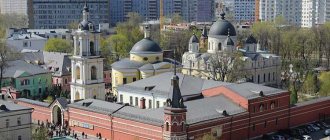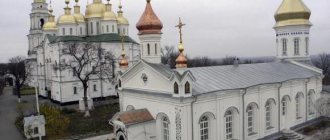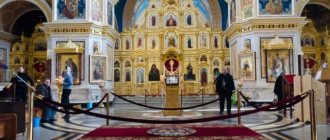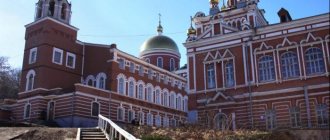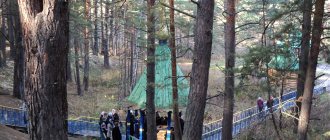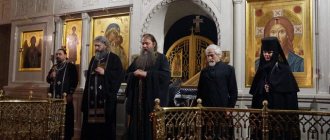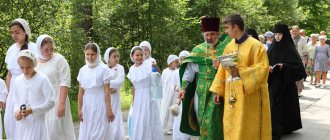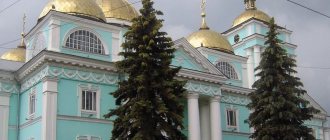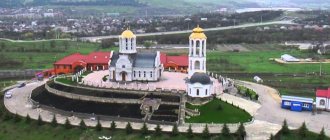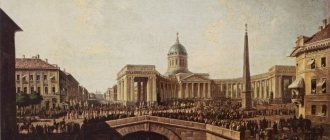Mir
Russia Ryazan Region Ryazan Kazan Convent (Ryazan) Map is loading...
{"format":"leaflet","minzoom":false,"maxzoom":false,"limit":50,"offset":0,"link":"all","sort":[""], "order":[],"headers":"show","mainlabel":"","intro":"","outro":"","searchlabel":"\u2026 \u0441\u043b\u0435\ u0434\u0443\u044e\u0449\u0438\u0435 \u0440\u0435\u0437\u0443\u043b\u044c\u0442\u0430\u0442\u044b","default":"","import-annotation":false,"width ":"auto","height":"350px","centre":{"text":"","title":"""link":"""lat":54.63177699999999958890839479863643646240234375,"lon": 39.76308999999999826968632987700402736663818359375,"icon":""},"title":"","label":"","icon":"","lines":[],"polygons":[],"circles":[ ],"rectangles":[],"copycoords":false,"static":false,"zoom":8,"defzoom":14,"layers":["OpenStreetMap"],"image layers":[] ,"overlays":[],"resizable":false,"fullscreen":true,"scrollwheelzoom":true,"cluster":false,"clustermaxzoom":9,"clusterzoomonclick":true,"clustermaxradius":80, "clusterspiderfy":true,"geojson":"","clicktarget":"","showtitle":true,"hidenamespace":false,"template":"","userparam":"","activeicon": "","pagelabel":false,"ajaxcoordproperty":"","ajaxquery":"","locations":[{"text":"\u003Cb\u003E\u003Ca href=\"/palomnik/%D0% 9A%D0%B0%D0%B7%D0%B0%D0%BD%D1%81%D0%BA%D0%B8%D0%B9_%D0%B6%D0%B5%D0%BD%D1%81% D0%BA%D0%B8%D0%B9_%D0%BC%D0%BE%D0%BD%D0%B0%D1%81%D1%82%D1%8B%D1%80%D1%8C_(%D0 %A0%D1%8F%D0%B7%D0%B0%D0%BD%D1%8C)\» title=\»\u041a\u0430\u0437\u0430\u043d\u0441\u043a\u0438\u0439 \u0436\ u0435\u043d\u0441\u043a\u0438\u0439 \u043c\u043e\u043d\u0430\u0441\u0442\u044b\u0440\u044c (\u0420\u044f\u0437\u0430\u043d\u0 44c)\»\u003E\u041a\ u0430\u0437\u0430\u043d\u0441\u043a\u0438\u0439 \u0436\u0435\u043d\u0441\u043a\u0438\u0439 \u043c\u043e\u043d\u0430\u0441\u0 442\u044b\u0440\u044c (\u0420 \u044f\u0437\u0430\u043d\u044c)\u003C/a\u003E\u003C/b\u003E\u003Chr /\u003E\u003Ca href=\"/palomnik/%D0%A1%D0%B2%D0%BE% D0%B9%D1%81%D1%82%D0%B2%D0%BE:%D0%90%D0%BD%D0%BD%D0%BE%D1%82%D0%B0%D1%86%D0 %B8%D1%8F\" title=\"\u0421\u0432\u043e\u0439\u0441\u0442\u0432\u043e:\u0410\u043d\u043d\u043e\u0442\u0430\u0446\u0438\u044f\"\ u003E\u0410\u043d\u043d\u043e\u0442\u0430\u0446\u0438\u044f\u003C/a\u003E: \u0436\u0435\u043d\u0441\u043a\u0438\u0439 \u043c \u043e\u043d\u0430\u0441 \u0442\u044b\u0440\u044c \u0420\u044f\u0437\u0430\u043d\u0441\u043a\u043e\u0439 \u0435\u043f\u0430\u0440\u0445\u0438\u0438 \u0420\u0443\u0441\u0441\u043a \u043e\u0439 \u041f\u0440\u0430\u0432\u043e\u0441\u043b\u0430\u0432\u043d\u043e\u0439 \u0426\u0435\u0440\u043a\u0432\u0438 \u0432 \u0433\u043e\u0440\u043e \u0434\u0435 \u0420\u044f\u0437\u0430\u043d\u0438","title":"\u041a\u0430\u0437\u0430\u043d\u0441\u043a\u0438\u0439 \u0436\u0435\ u043d\u0441\ u043a\u0438\u0439 \u043c\u043e\u043d\u0430\u0441\u0442\u044b\u0440\u044c (\u0420\u044f\u0437\u0430\u043d\u044c)","link":"","lat": 54.6317769999999999958890839479863643646240234375, "LON": 39.7630899999999982696863298770040273666663818359375, "ICON": ""}], "IMAGELYARS": "IMAGELY []}
54.636882; 39.760018
Russia, Ryazan, Nizhny Posad
Ryazan, Ryazan region
Russia
Phone fax
: 27-33-60
Kazan Yavlensky Monastery
- a convent of the Ryazan diocese of the Russian Orthodox Church in the city of Ryazan.
History[[edit]h2>
Founded in the 16th century on a hill at the confluence of the Lybid and Trubezh rivers (the territory of the Ryazan Kremlin). According to local legend, the miraculous icon of the Mother of God of Kazan was revealed at this place.
In 1786, it was moved to the Ascension Church in the city of Ryazan at the entrance to the city from the Vladimir horse-drawn road “in Novinki” (modern Zatinnaya Street), where it is located to this day.
In 1861, under Abbess Catherine, in order to care for the old and infirm sisters who could no longer work and required a caretaker, a community and a hospital were established in the monastery.
Since 1863, Evgenia (the second) became the abbess of the monastery, through whose efforts the monastery began to shine anew. Thus, at the expense of the banker and philanthropist Sergei Afanasyevich Zhivago, a four-year school for girls was opened at the monastery in 1868. On the site of the dilapidated Ascension Church, at the expense of the Moscow merchant Nikanor Petrovich Suvorov and other benefactors, a new cathedral church was built in honor of the Kazan Icon of the Mother of God with chapels of the Hieromartyr Charalampius and St. Sergius of Radonezh. On August 16, 1870, Archbishop Alexy (Rzhanitsyn) consecrated the cathedral. In the same year, a gate church was built on the territory of the monastery in honor of the Great Martyr Barbara; a bell tower rose above the church.
In 1872, the monastery received first-class status. In addition to these temples, there were 40 more separate buildings for various purposes on the territory, including a library-reading room, a bakery, and a candle factory. There was a cemetery at the monastery where not only nuns were buried, but also townspeople famous for their services. The monastery was surrounded by a stone fence with two gates - eastern and western. Outside the monastery there was a monastery hotel and a vegetable garden with an area of 2.5 hectares. The number of nuns by 1917 was about 400.
After the revolutionary events of 1917, the destruction of the monastery began, which was finally liquidated in 1919: the nuns were expelled, all its valuables were requisitioned, and the territory of the monastery with a high stone fence was ideal for the Bolsheviks to imprison the first victims of the revolution and organize a concentration camp of forced labor. Some of the buildings of the former monastery were allocated for apartments for the camp commandant and staff, while some of the buildings were occupied by armed guards.
On February 20, 1923, the Ryazan provincial forced labor camp was disbanded, after which a Red Army club was set up in the Kazan Church, and the paintings on the walls of the temple were painted over with revolutionary pictures. Later, a colony for street children was located within the walls of the monastery, and sewing production of military uniforms was organized. Most of the walls and towers of the monastery were dismantled by order of the authorities “for the needs of the city state farm” (only the tower and a piece of the wall of the monastery at the corner of Zatinnaya and Voznesenskaya streets were preserved), part of the monastery premises, including the gate church with a bell tower, were given over to residential apartments (later some of them were rebuilt and privatized), some were abandoned. The monastic necropolis, where many famous Ryazan residents were buried, in particular, a descendant of the militia governor Minin and Pozharsky, Count M.D. Buturlin, Ryazan governor P.S. Kozhin, philanthropist S.A. Zhivago, was almost completely destroyed. In 1924, the provincial (later regional) archive was placed in the Kazan Cathedral.
Description of the architecture
Initially, the Kazan Convent occupied an entire block along Furmanov Street and included more than 40 different buildings, including two churches. Today the monastery is just in the process of being revived after the devastating years of neglect during the USSR. Restoration will not only help restore destroyed buildings, but also return them to as close to their original appearance as possible.
The Kazan temple was laid out of stone using solid masonry technology, without gaps. Its walls were covered with a thick layer of lime inside and out, and the roof was covered with thick sheets of black iron. The roof was also painted with special oil-based white paint. On the domes there were slotted crosses, which were covered with gold leaf. Their base was strengthened in the same gilded apple-heads. On the southern and northern sides of the building there were oblong windows, semicircular at the top. They were decorated with artistic forged steel designs.
The refectory and altar hall were made to look like marble - their floors were lined with yellow marble slabs. The vaults were made in the form of domes and chandeliers were lowered from their centers downwards on chains. The walls and vaults themselves were decorated with paintings of holy scenes, but their author is unknown. In terms of the style of writing (a subtle combination of church canons and artistic painting), the paintings resemble the work of the master of painting Shumov, who lived in Ryazan in 1857 - 1904.
Interior decoration of the Kazan Church
Above the altar vault were three huge iconostases covered with gilding and rich decorations. The main one had three tiers and it was in it that the miraculous icon of the Mother of God “Kazan” was installed. The Kazan temple was heated with an oven and therefore services were held there all year round.
The second church of the monastery was the gate church and was located above the western gate. It was consecrated in honor of the Great Martyr Barbara in 1870. It was in it that there was an entrance to the nunnery. The temple had a special architecture - it was combined with a tier of a bell tower, which was square in shape. It was crowned by a head together with a large cross, and the bell tower had 1 bells. This church was unheated and services were held here only in the warm season.
After the looting, the temple was given over by the Soviet authorities as a simple residential building, and it remains that way to this day.
Current state[[edit]h2>
On December 16, 2005, the building of the Kazan Cathedral of the monastery was transferred to the Ryazan Diocese. On November 4, 2006, the first prayer service took place in the Kazan Cathedral in front of the Kazan Icon of the Mother of God.
In October 2007, the Ryazan Diocesan Women's Theological School was opened at the monastery, transformed from the School of Psalm Regents at the Ryazan Orthodox Theological Seminary.
By the decision of the Holy Synod of June 23, 2008, nun Anna (Sychugova) was appointed abbess of the Kazan Convent.
Activities of the parish
Today the monastery is under the control of Abbess Anna (Sychugova). Divine services are held here daily according to the established schedule:
- morning service at 7 am on weekdays, and at 8 am on holidays;
- Vespers at 5 pm;
- lithium for the deceased daily at 6.40 am;
- on Sunday holidays there is also a water prayer service at 9 am.
On a note!
In addition to divine services, since 2007, the Ryazan Women's Diocesan Theological School has also been operating on the territory of the monastery. It became a continuation and transformation of the previously existing school of regents-psalmists. Today, any girl can enter the school if she wishes and upon graduation receive an appropriate diploma. The monastery publishes the periodical “Bulletin of the Kazan Monastery” and operates a Sunday school for adults and children.
Shrines[[edit]h2>
Revered Icon of the Mother of God “Kazan”
• Miraculously revealed Miraculous Kazan Icon of the Mother of God.
• Ark with a particle of the relics of the Holy Apostle Simon the Canaanite
• Ark with part of the relics of Blessed Lyubov of Ryazan
• Icon of Peter and Fevronia of Murom with a particle of relics
• Icon with a particle of the relics of Blessed Vasily Kadomsky
• Icon of the Mother of God “Kaplunovskaya”
• Icon of the Mother of God “Quick to Hear”
• Athos image of the holy great martyr and healer Panteleimon
• The miraculous image of St. Nicholas, Archbishop of Myra in Lycia, wonderworker
• Ark with a particle of the relics of the Venerable Confessor Anna Sreznevskaya
• Revered Icon of the Mother of God “Kazan”
History of the monastery
The further existence of the monastery, which received the name of Kazan
, developed traditionally.
The nuns ran a simple household and spent a lot of time in prayer. Every year the monastery organized a walking religious procession
with the carrying of the icon of the Mother of God from the walls of the monastery to the city of Romanov, and from the 19th century believers began to go to Rybinsk. The number of nuns grew, many of whom stood out for their icon-painting and gold-embroidery skills; the monastery was also famous for its church chants.
From the 17th to the mid-18th century, the monastery existed, according to royal charters, on customs payments. Under Catherine II
he was transferred to government pay.
The monastery became a dormitory at the beginning of the 19th century
, and before that each sister lived at her own expense.
But the main material injections were gifts from wealthy Orthodox citizens and Russian sovereigns. During the entire period of the pre-revolutionary existence of the monastery, it was headed by 29 abbesses
.
View of the Kazan Convent, photograph from the 19th century
Gradually, new churches and other structures appeared on the monastery territory. By 1649
The wooden Kazan Church is being rebuilt in brick.
However, work on its side chapels, wall paintings, etc. continued for a long time. The temple itself was consecrated in 1673
, and the walls were painted by the 80s, under Metropolitan Ion Sysoevich. After another four years, a stone refectory with a warm aisle was built. Its entrance is decorated with a tented bell tower.
Apart from the main Kazan Church, almost all the other monastery buildings remained wooden for a long time, so the “great fire”
caused impressive destruction to the monastery. But the monastery is gradually being rebuilt.
The Great Fire of 1658 in Yaroslavl
By the middle of the 18th century
The territory of the Kazan Monastery already has a stone fence. Above the entrance gate was the Temple of John the Baptist. At the end of the 18th century, the warm Church of the Savior Not Made by Hands began to function.
At the beginning of the 19th century
wooden cell buildings were replaced with stone ones.
The abbess's chambers were also built in stone. The monastery walls are being rebuilt, and towers are being erected at the corners. In the 20s Church of the Intercession of the Virgin Mary
also appears in the 19th century .
The Holy Gate adjacent to the temple is decorated with a 60-meter four-tiered Bell Tower
, on which 10 bells are installed.
In 1835-45
.
under the leadership of the provincial architect P. Pankov, instead of the former Kazan Cathedral, a new Kazan Cathedral
(
architect A. Melnikov
) was built, which still exists today. The new building, decorated with columns and semi-columns, was erected in the late classical style, which was very popular at that time. The chapters had octagonal tower shapes. Inside, the temple was equipped with a three-tiered carved iconostasis, which was also equipped with columns. The walls of the temple were painted by a team of local artists.
Kazan Cathedral - photo of the main temple of the Kazan Convent
In the second half of the 19th century, the abbess's chambers were supplemented by the one-domed house Church of the Presentation of the Lord
.
By the beginning of the 20th century
The monastery territory occupied an entire block, located between today's Trefoleva and Pervomaiskaya streets, northeast of the current Volkov Square. About three hundred nuns and novices lived at the monastery, and the parochial school had more than 60 students.
The monastery owned numerous plots of land and buildings in the city itself and in its environs, flour mills, etc. On the Trans-Volga monastery territory there was a cemetery with an almshouse and the Church of Our Lady of Tikhvin. The main monastery territory was also constantly improved.
After the suppression of the Yaroslavl anti-Bolshevik uprising, Soviet power
.
The monastery as an Orthodox organization is abolished. The remaining nuns are transferred to the Tolga Monastery. And in the former peaceful monastery walls there is a concentration camp
for political “enemies of the people”, then the cathedral building was used for the city archive, and the remaining buildings for housing and other needs.
In the Church of the Intercession
, for example, a library was located, and then the city Planetarium.
Planetarium in the building of the Intercession Church. Soviet period
Former monastic buildings were converted into a Peasant's House
and storage facilities, for
barracks
and educational institutions. The monastery's beautiful bell tower and chapel were demolished.
The Church of the Intercession continued to function as a parish church for a short time, so the main monastery holy icons
— Savior Not Made by Hands,
Our Lady of Kazan
and the Three-Handed Lady.
But the Church of the Intercession was also closed. Then all the holy images were transported to the Church of the Exaltation of the Cross, but by the 1930s it too was liquidated. The further fate of the monastery icons is unknown. A frame
remains of the Yaroslavl-Kazan Mother of God , which tourists can see in the Old Russian department of the Art Museum.
Kazan Monastery without crosses in the Soviet years
In the 20th century
Since the beginning of the 90s, the gradual return of monastic buildings to the Yaroslavl diocese began. Residents moved in, archives were removed, restoration began, and so on and so forth...
In 1998
the buildings and territory of the Kazan convent are returned to believers.
The main monastery shrine
becomes one of the copies of the Yaroslavl-Kazan Mother of God, painted by local icon painters in the pre-Soviet period.
With the beginning of the 21st century, the main monastery church - the Kazan Cathedral
- began to hold regular services.
Gate to the territory of the Kazan convent
Today this convent lives an ordinary Christian life. Educational institutions were organized under it - the regency school
and Orthodox
gymnasium named after.
St. I. Brianchaninov. The tradition of the summer
Tutaevsky procession
with the carrying of the iconographic image of the Kazan Mother of God through Tutaev and other Volga settlements to Rybinsk has been renewed. Everything is back to normal.
Tutaevsky religious procession 2021
Patronal holidays[[edit]h2>
Icon of the Blessed Virgin Mary “Kazan”
— July 21, November 4
December 17
- Day of Remembrance of the Holy Great Martyr Barbara
Charalampius of Magnesia, holy martyr
- February 23
Sergius of Radonezh, Venerable
— Cathedral of Moscow Saints, July 18, October 8
History of the formation of the monastery
The legendary story of the discovery of the Kazan Icon of the Mother of God by a nine-year-old girl Matrona
in the Kazan ashes
of 1579
is perhaps familiar to everyone. This newfound image was almost immediately recognized as miraculous, and pilgrims from other cities flocked to it.
Gerasim Trifonov , who was in Kazan on business, to heal
, who acquired her list and brought it to the city of
Romanov
(now Tutaev)
in 1588
. Moreover, both the acquisition of the list and its delivery to Romanov were carried out, according to legend, by the will of the Mother of God herself, whom Gerasim saw in his dreams. Fulfilling her will, together with the residents of Romanov, Gerasim builds a wooden Church in the name of the iconographic image, where it remains until the onset of the Time of Troubles.
Icon of Our Lady of Kazan
Early 17th century
, after the capture of Romanov by Polish-Lithuanian troops, the miraculous icon of the Mother of God of Kazan ends up in
Yaroslavl
.
Some believe that her move is connected with a certain Lithuanian officer, others associate this event with the Orthodox Yakov Lyubsky. It is possible that this is one and the same person. One way or another, the icon ultimately came to the Yaroslavl elder and was installed in the parish Church of the Praise of the Mother of God.
During the powerful and final offensive of the Polish troops on Yaroslavl, the Icon of Our Lady of Kazan was temporarily moved to the then wooden Church of the Nativity of Christ near the Volzhskaya embankment. The defenders of the city believed that it was the Mother of God who helped save the city, because neither the Yaroslavl Kremlin nor the Spaso-Preobrazhensky Monastery were captured by the enemies.
Church of the Nativity
After these events, the Most Holy Theotokos appears in dreams to the deacon of the Church of the Exaltation of the Cross, Eleazar
with the will to establish a church for her image.
The construction of a new temple took place in 1610
on the territory of the town near the border of Zemlyanoy Town.
The rescued Romanov icon was transferred there, which is now called Yaroslavl-Kazan
. And a list of her is sent to Romanov, which is installed in place of the previous image in the local Kazan temple.
the Nativity Convent, destroyed by enemies, began to settle
, previously located in the area of the current Epiphany Square. More than 70 nuns began to build living cells, utility buildings, etc. Thus, the founding of a new convent, which became the successor to the Nativity Monastery, spontaneously occurred.
How to get there[[edit]h2>
Address:
391103, Ryazan region, Rybnovsky district, village. Konstantinovo
Telephone:
8-903-641-97-07; 8-910-641-33-87 (rector Archpriest Alexander Kuropatkin)
Email:
Directions:
From Ryazan (Tsentralnaya bus station on Moskovskoe highway) 6.10 bus, 8.00 minibus (from Rybnoye), 9.40 bus, 12.00 march (from Rybnoye), 13.40 bus, 16.30 march (from Rybnoye), 18.35 bus.
To Ryazan 7.30 bus., 8.30 march. (to Rybnoye), 11.00 bus., 12.30 bus. (to Rybnoye), 15.00 bus., 17.00 march. (to Rybnoye), 20.00 bus. The bus stops at the entrance to the village.
More information about using your own transport can be found here.

